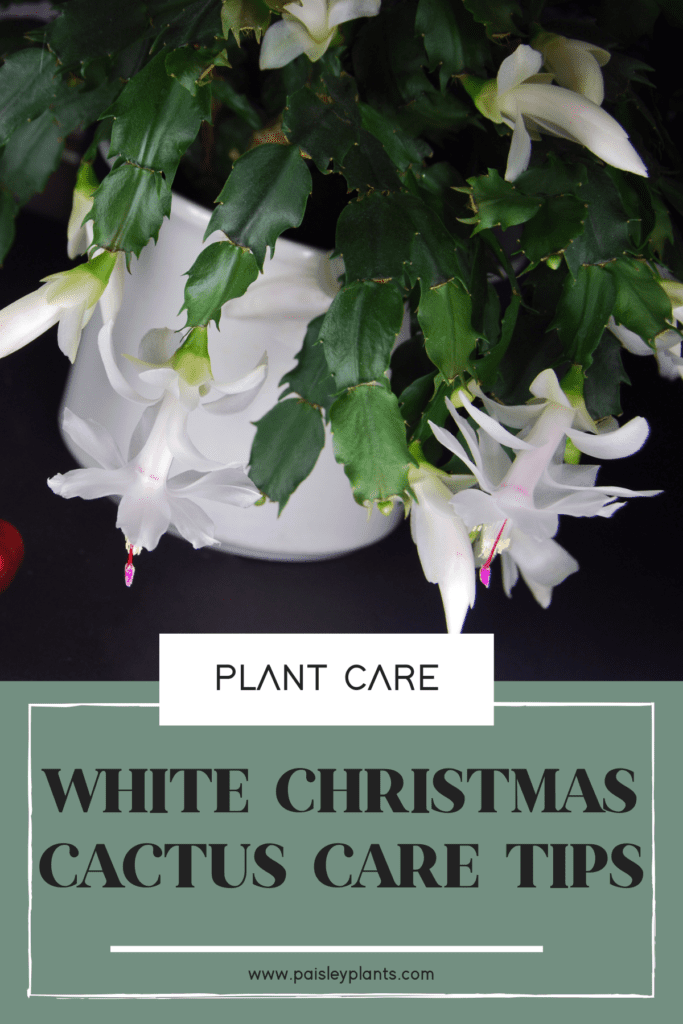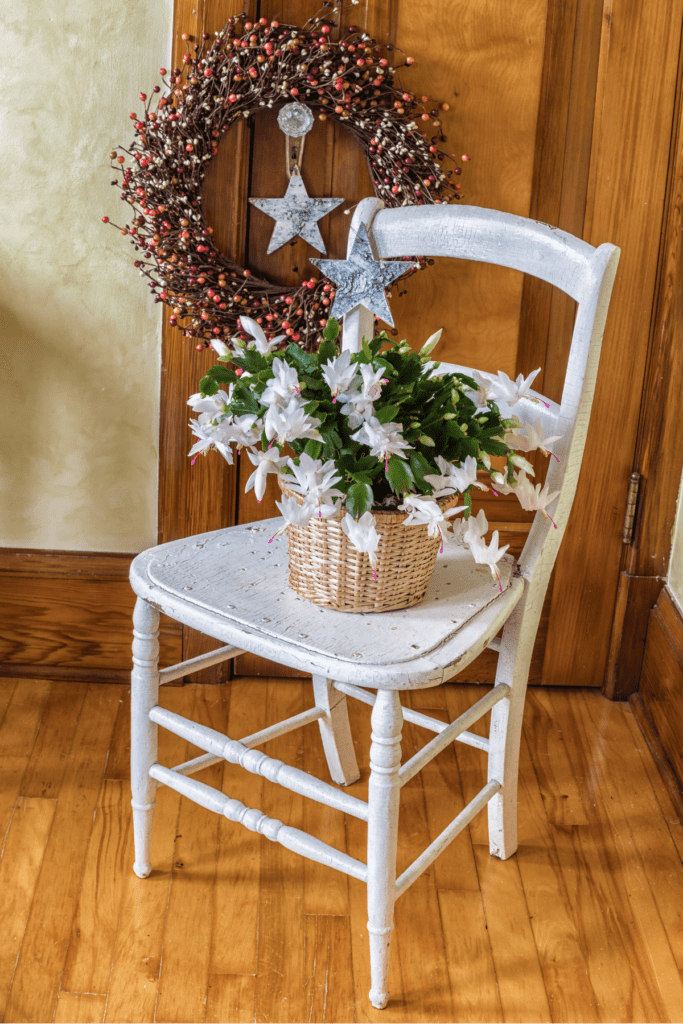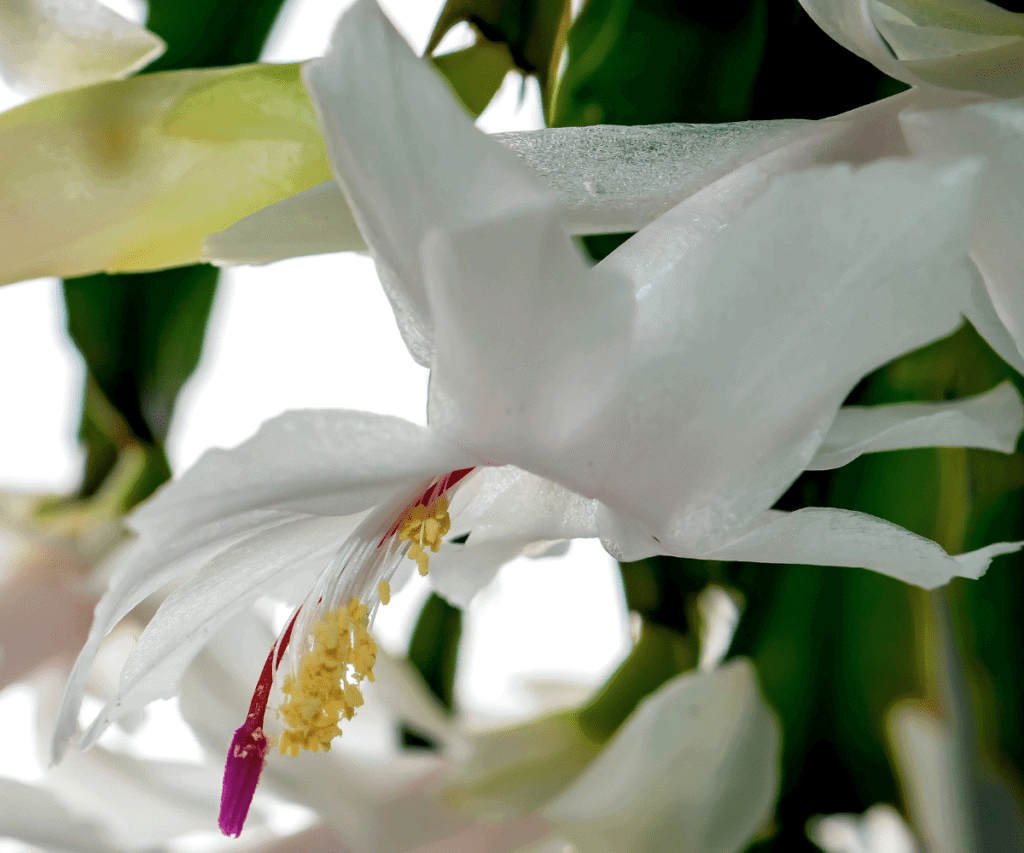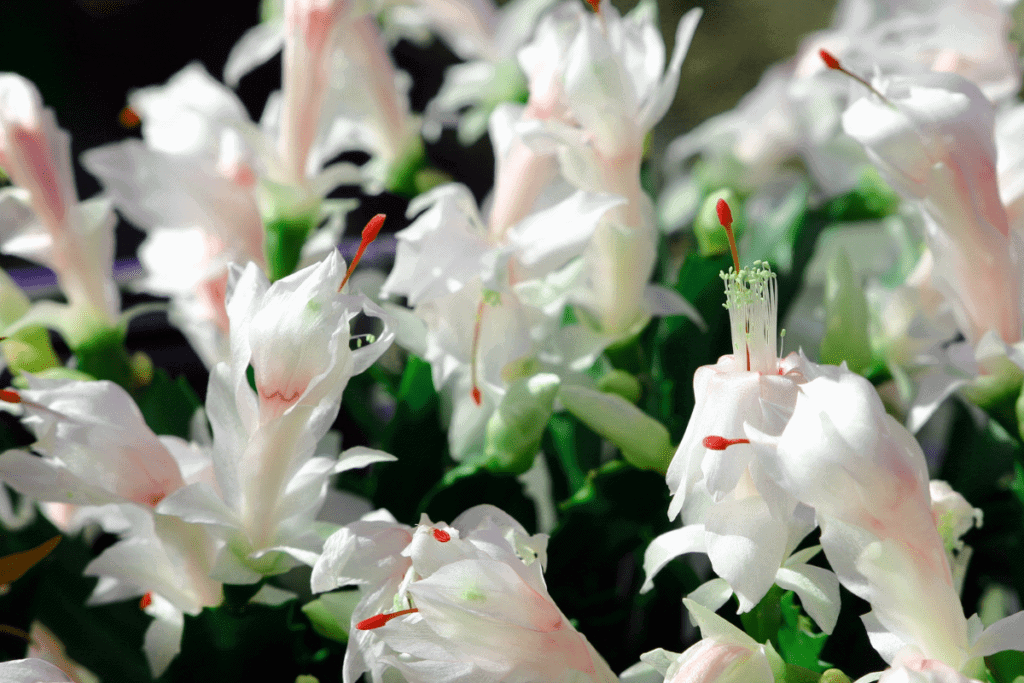I’m dreaming of a white Christmas… cactus! White Christmas cacti are unique, beautiful, and so easy to care for. They are one of the most beautiful type of houseplants you can find.
A blooming Christmas cactus is one of the most beautiful holiday houseplants to display in your home.
Native to the tropics of southern Brazil, the white Schlumbergera x buckleyi, or the white Christmas cactus, is a rarity to most cacti. The white Christmas cacti don’t live in hot, arid environments such as deserts or plains. Their natural habitat is the rainforests of southeastern Brazil.

This post includes affiliate links.
You may have noticed different nicknames for this type of plant which include Thanksgiving cactus and Easter cactus. These are all variants of the Schlumbergera plant. They are also sometimes referred to as Holiday cacti.
The difference between these varieties is based on when their flowers bloom and have slight differences in the shape of their leaves, which are called clades. Thanksgiving cacti are the earliest and longest bloomers, typically producing flowers from late fall through mid-winter.
Easter cacti bloom from late winter to mid-spring. True to their name, white Christmas cactus bloom near late December.
The white Christmas cactus is identifiable by its long branches composed of flattened, green leaves, called clades. These clades have rounded, notched edges.
At full maturity, the white Christmas cactus will reach a height of 6 to 12 inches, and a spread of 12 to 24 inches.
Contrary to their name, the branches of the white Christmas cactus are not actually white. Rather, the color refers to the hue of the blooms that this cactus produces.
You can expect white flowers to bloom from the ends of these branches. The flowers on these white Christmas cacti are tubular in shape with a double flower appearance.
While the white Christmas cactus is not deadly to humans and animals, consumption of this plant is not advised. Consuming a white Christmas cactus can cause severe intestinal distress.
Table of Contents
White Christmas Cactus Care Tips

Sun & Light
White Christmas cacti enjoy partial shade/diffused light. Avoid exposing your cactus to direct sunlight at all costs; it can cause the branches to become pale and yellow.
White Christmas cacti prefer more humid environments, which makes a bright bathroom or kitchen a good spot to keep them. You will find that placing your cactus within three feet of a large south, east, or west facing window with a stable temperature condition is the best placement for this type of houseplant.
Soil Type
In its natural habitat, the white Christmas cactus grows as an epiphytic plant. Epiphytes do not grow in traditional “soil.” Rather, they grow atop trees or rocks; this is purposeful to increase air circulation between its roots.
As a houseplant, the white Christmas cactus will tolerate most soil types. However, to get the best results, we recommend planting your cactus in soil that is slightly acidic and very well-draining. Most cacti soil mixes are suitable for this plant.
Water
Despite being a cactus, the Shlumbergera is native to tropical regions and requires more water than the stereotypical cactus. Give your plant a thorough watering, until excess water starts to leak from the drainage holes.
Place a tray underneath the pot to catch the water. After about 10-15 minutes, discard any excess water in the tray so the pot doesn’t sit in water. Wait until the soil is almost completely dry before rehydrating your plant.
Be sure to water your plant consistently while it is in bloom. If the plant dries out too much, it may drop its buds.
During the hot summer months and depending if you place your Christmas cactus outdoors, your plant may require more water than usual due to the higher rate of evaporation.
Monitor your soil’s moisture levels and don’t be afraid to stick a finger into the soil to physically feel the water level. Only water when the top third of the soil feels dry to the touch. Be sure to check your plant each day to ensure it does not dry out.

Fertilizing
Though the early spring and summer, apply a diluted water soluble plant food; aim for a balanced NPK ratio. This should be done once a month.
The white Christmas cactus has a higher requirement for magnesium than many other plants. Fertilize monthly during the growing season with Epsom salts (magnesium sulfate) mixed at one teaspoon per gallon of water. This should not be used the same week as the regular fertilizer, however.
As the blooming season approaches and you notice flower buds, halt fertilizing altogether. Once its flowers have bloomed, you may resume your monthly feedings.
Temperature & Humidity for White Christmas Cactus
The Schlumbergera is finicky when it comes to air temperatures depending on the time of year. During its active growing season, it prefers warm temperatures ranging from 70° to 80° F.
As the winter approaches and its buds are setting, they require low night temps at around 55° to 65° F.
The white Christmas cactus differs from most other cacti in that it prefers humidity. Plant owners should be especially aware of their homes’ humidity level during the winter when the heater is turned on; the heated air tends to be little drier than what the white Christmas cactus enjoys. You can raise the humidity level by introducing an electric humidifier or a pebble tray.
Schlumbergera Pruning & Maintenance
The ideal time to prune your Schlumbergera is right after it blooms. During this time, the plant will begin to emerge into its new growing period. Pruning will encourage the plant to grow more branches.
You can prune your white Christmas cactus by twisting and snapping off its stems. Alternatively, you can also use a knife or pruning shears to cut off pieces of the branches. Avoid pruning more than 1/3 of the plant.
Choosing a Container & Repotting
The most important thing to look out for when selecting a pot for your Schlumbergera is drainage. Your plant pot should have at least one drainage hole at the bottom in order to keep your soil from becoming too waterlogged.
You may wish to repot your white Christmas cactus every 2 years. However, white Christmas cacti like to be rootbound, so may not have to be repotted more than every three to four years.
When repotting, we recommend selecting a planter that is slightly larger than the current one. Usually a pot one to two inches larger than the current pot is sufficient for replanting. Wait until the blooming is done and flowers have wilted in late winter or early spring. The plant should not be repotted while actively blooming.

How to Propagate a White Christmas Cactus Plant
The white Christmas cactus is best propagated by rooting stem cuttings. We recommend propagating your plant one to two months after it finishes blooming.
Follow these steps to successfully propagate your Christmas cactus:
- Start by preparing a small plant pot filled with well-draining soil.
- Using a clean pair of shears, cut off a branch that has 3 to 5 segments on it.
- Place the stem in a location that is cool and dry for 2-4 days or until the cut end dries out; this protects the stem from rotting.
- Lightly moisten the soil that is in the plant pot and bury the stem about 1 inch deep.
- Your stem is more likely to root in a humid setting. Place a clear plastic bag over the planter and remove when your stem has begun to root. Wait until the soil has dried entirely before re-watering.
- It takes roughly 2 to 4 weeks for rooting to occur. The best sign of rooting is noticing new growth coming from your stem.
- Wait for 8 to 10 weeks to transplant your rooted stem to a full-size plant pot.
Common Pests
Common pests that can affect your Christmas cactus are fungus gnats, flower thrips, aphids, spider mites, and mealybugs. Pests like to affect weak, overwatered plants; the most important pest prevention is to water your plant properly and care for it meticulously.
If your plant is unfortunately affected by any pests, they are treatable when caught early. Products such as neem oil and insecticidal soap are effecting pest control measures. Smaller pests can also be controlled by blotting your plant with a cotton ball soaked in rubbing alcohol.
Common Diseases
Overwatering your Christmas cactus can expose it to harmful fungi such as Fusarium and Phytophthora. Both fungi develop at the base of the plant’s stem by the soil line.
Common symptoms include brown spots and wet stems. Phytophthora is incredibly deadly and will cause your plant to perish.
On the other hand, fusarium can be remedied when caught early. In order to treat fusarium, allow your soil to dry our completely and apply an anti-fungal remedy to your plant according to the package instructions.
Where to Buy
FAQ
Shriveling, or puckered leaves are a sign that your plant is dehydrated. Give your cactus a deep watering; pour water until you notice the excess leaking our from the drainage holes. Keep in mind that while you should wait for the soil to almost dry before re-watering, avoid going long periods of time in between waterings.
Yes. Christmas cacti will continue to bloom every year as long as the plant is properly cared for. A well cared for white Christmas cactus may bloom for decades if well cared for. A sick plant is less likely to produce flowers. You may find that your Christmas cactus plant will bloom more than once a year, depending on light conditions.
When cared for properly, you can expect your white Christmas cactus to live for 20 to 30 years. Be sure not to toss it out once it blooms! It can survive for decades and bloom year after year.
Yes. The fruit produced by white Christmas cacti is able to be harvested for its seeds. The seeds grow in pods at the base of the flowers. These seeds can be propagated into creating a new Christmas cactus.
Growing a white Christmas cactus from seeds is quite easy; follow these steps:
Plant the seeds in hydrated sphagnum peat moss and vermiculite. Cover the container with clear plastic wrap in order to create a humid environment.
Place the container in a location with bright, indirect light. Keep the growing medium consistently moist.
The seeds should sprout roots within 3 weeks. When you notice seedlings, remove the plastic wrap.
Once the seedlings are large enough to be handled, transplant them to individual plant pots filled with soil.
It takes 18 months for a seed to turn into a viable Christmas cactus.
In Conclusion
If you’re looking for a houseplant that is interesting to look at, yet easy to care for, then look no further than the white Christmas cactus. These houseplants are usually found only in gardening centers around holiday time.
Years ago, the only place to find a white Christmas cactus was at a garden center that propagated them exclusively. It’s possible to find these type of plants at a garden center, but when you shop for your plant, be sure to check the plant for the shape of its clades to identify it properly.
Some will be labeled as a Christmas cactus, but are actually Thanksgiving cactus. Some garden centers sell a mix of these type of cacti. However, the white Christmas cacti droopy branches combined with its gorgeous white flowers make this plant quite the centerpiece!
This plant will brighten your winters with its blooms and add a bit of variety to your succulent houseplant collection. Every day the flowers are in bloom will carry on the dream of a white Christmas!
Check out some of these fun plant guides!
